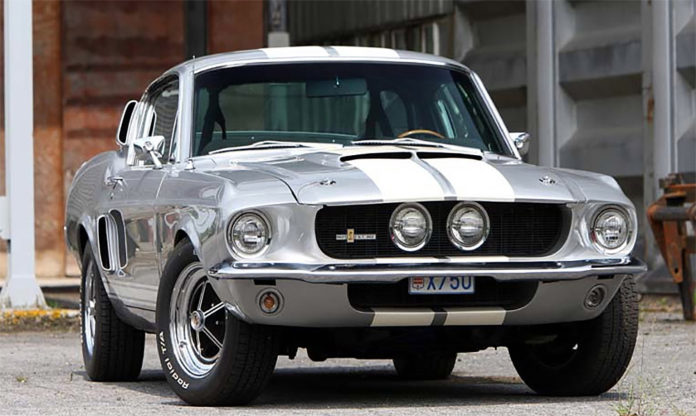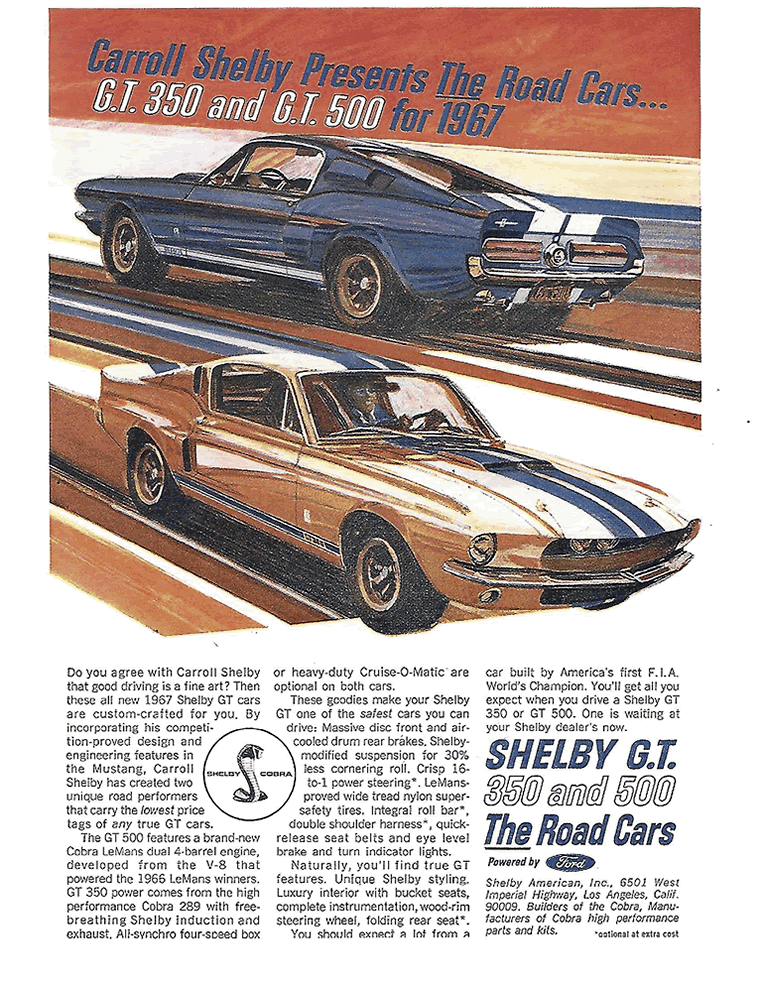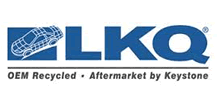As the Francis collection began to grow, our Executive Editor Jeff Francis and his father Ben decided it was time to seek a new restoration project. Being that Ben had an affinity for Ford Mustangs, it was decided that only a Shelby would satisfy the proverbial hole in their collection.
Shelby Mustangs became classics almost from the moment they rolled out of Carroll Shelby’s Venice, California shop. The 1965 and 1966 models were truly race cars with a license plate, having brought home wins in various classes of amateur and professional road racing. If the Cobra did not make Carroll Shelby a household name, the GT350 cemented the marque as an American Icon.
For 1967, the Mustang underwent its first redesign. That year, Chevrolet introduced the Camaro, which pressured Ford into making various changes in order to remain leaders in the Pony Car segment. 1967 brought a larger exterior, increased interior space, and the introduction of the big block engine.
In order to keep up with exploding demand, Shelby redesigned their offerings for the 1967 model year. Not only was the 1967 GT350 redesigned, a new model dubbed the GT500 was introduced. Both the GT350 and GT500 were based upon the standard Ford Mustang, but included a myriad of mechanical and superficial changes. The 1967 Shelbys featured a longer, fiberglass hood, revised fascias, inboard high-beam lamps, and tail lights from the 1967 Cougar. The GT500 featured a dual four barrel-equipped 428 cubic inch V8 touting 355 horsepower, while the GT350 retained the 289 cubic inch HiPo (K-Code) V8 from the earlier GT350s, but was now producing 306 horsepower.
Francis and his father settled upon a GT350, for very good reason. Only 1167 GT350s were produced in 1967, as opposed to 2048 GT500s, making the GT350 nearly twice as rare as the GT500. Not to mention, the prices of GT500s seemingly exploded overnight, making even rough examples prohibitively expensive when compared to the GT350. More importantly, the GT350 was thought to be a more “pure” driving experience, featuring more than adequate power from the K-Code 289 at a greatly reduced weight.
The search for a 1967 GT350 proved to be quite difficult for Francis and his father. Due to the desirability of these cars, it was not an easy task to pry one away from their current owners. Francis networked with his list of contacts, placed wanted ads and scoured both internet and print classified to no avail.
An advertisement in the LA Times finally proved fruitful after receiving a call from a gentleman in Tehachapi. The man had owned a 1967 GT350 for the better part of two decades and had actually begun a restoration on the car. After conversing with the Shelby owner, Francis learned that they both shared road racing backgrounds which provided lengthy conversation. Once the Shelby was discussed, the man exhibited a sense of hesitation and indecisiveness, a seemingly common trait amongst sellers in the classic car community. Unfortunately, the man’s hesitation won out, but he had agreed to call Francis if he were to have a change of heart. After a few months, the man from Tehachapi decided he was ready to sell. Pricing and logistical issues were rectified, and a transaction date was agreed upon. After making travel arrangements, Francis received a call from the seller stating that he no longer wished to sell the car.
Three months elapsed, and Francis has yet to find “the” Shelby to suit his needs. The man from Tehachapi called seemingly out of the blue, apologizing for his prior indecisiveness. This time, he said, he was finally ready to sell. Francis and his father Ben anxiously hooked up their car trailer and headed South, cash in hand. Halfway through the three-hour trip, the man cancels a second time, sending Francis and his father back to Fresno empty handed.
Nearly 6 months after their original contact, the man calls once more and asks Francis if he was still interested. Having yet to find a suitable example, Francis AGAIN makes plans to head out to Tehachapi with his father. Almost like clockwork, his phone rings halfway through the trip, and is subsequently ignored.
Upon arriving at the seller’s home, it is quickly apparent to Francis and his father Ben, that that they were dealing with a fellow motorhead. The man’s property isn’t unlike Ben’s, with incomplete restoration projects seemingly scattered across the premises. It was no surprise that Ben and the seller hit it off almost immediately. During their conversation, the seller again began to express a touch of seller’s remorse and was trying to back out of the sale.
Francis had complete confidence in his father’s abilities to redirect the conversation, and began to give the GT350 a thorough inspection. It was not uncommon then for sellers, both knowingly and unknowingly, to be selling a run-of-the-mill Mustang instead of an authentic Shelby. It is easy for someone to go to a vendor and “order” a Shelby from a catalog, all it takes it a checkbook and some spare time.
All “Shelbys” have the fiberglass hood, and the badges; where most “recreations” fall short are in the details. Authentic Shelbys have functional rear brake air ducts that channel air from the side scoops through the wheel houses. They also feature rubber stop pads on the underside of the floor, directly over the rear end housing. Such miniscule details are often overlooked, and a surefire way to authenticate a Shelby with only a quick glance.
According to the Shelby American Automobile Club (SAAC) and their team of judges, the “best” way to verify a Shelby’s authenticity is to actually drill a rivet from its Shelby ID tag. This allows one to pivot the Shelby tag out of the way, revealing the original Ford VIN number stamped on the fender apron. A call to the Shelby Registrar allows one to verify that the Ford VIN is the correct one that corresponds to the number on the Shelby tag. Unfortunately, this process can be lengthy and not commonly one that would be completed at time of sale.
Fortunately for Francis, all other signs pointed to this being an authentic GT350. He gave his father Ben the proverbial “thumbs up” and Ben proceeded to close the deal with the owner before seller’s remorse would rear its ugly head again.The car was loaded on the trailer in a whirlwind of activity, in hopes that their deal wouldn’t unravel.
Upon getting the car back to their shop, Francis immediately accessed the ford VIN number and contacted the 1967 Shelby Registrar. Luckily, the numbers matched and the car was indeed an authentic 1967 GT350! Marti Auto Works was contacted, and a Deluxe Marti Report was ordered, giving a complete breakdown of the car’s production details.
As the Marti Report was being processed, initial teardown began. The engine was quickly taken out, and 40 years of grease was removed. To their surprise, the engine was actually the numbers-matching unit installed from the factory. It is no secret that a great number of these cars were hot-rodded early on in their history, and finding a true numbers-matching example is becoming increasingly difficult.
The Marti Report provided even more great news. Originally ordered in Medium Metallic Grey, this GT350 featured a laundry list of luxury options: the “Select-O-Matic” (C4) automatic transmission, “SelectAire” air conditioning, making it one of five examples produced in this combination. While perhaps spec’d more to be a boulevard cruiser than a crude race car, this GT350 was certainly equipped in an attractive manner for the now aging Shelby market.
Once the provenance of the car was confirmed, it was time to “finish” the restoration that had been started by the previous owner. Local Mustang restoration expert, Matt Barcellos, was tapped due to his encyclopedic knowledge of Shelby and Mustang restorations. With his assistance, a complete nut-and-bolt restoration was completed, bringing #1210 back to showroom condition.
Fresh off its restoration, the GT350 was invited to be one of the few automobiles displayed at the Saturday Night Gala that proceeds the Greater Valley Concours d’Elegance. The next day, on the show field, the Shelby had not only earned the “Best in Class” award, but the judges unanimously voted for it to receive the “Most Fun to Drive” award. Not bad for your first outing…
The Shelby’s next event was California’s premiere Central Coast car event, “The Classic at Pismo Beach Car Show.” Over 1000 cars were in attendance that weekend. As the Shelby snaked its way to the registration table, it was instantly selected as a “Gold Class Winner,” allowing it to compete in a designated area against a mere 17 other vehicles for the “Grand Prize”. Sunday morning it was announced the 1967 Shelby GT 350 was the winner of the coveted “Meguiar’s Platinum Best of Show Award.”
Some years after the restoration, it was discovered that the current silver color was lighter than the original Medium Metallic Grey. After some research, it was determined that Shelby incorrectly noted the Ford reference number on their internal documentation, resulting in an incorrect paint code. Fortunately, the original color was documented in photographs from the original owners, WHOO Radio of Orlando, Florida. Quoting Bill Love, host of the Billy Love Show on WHOO radio, in 1967:
“This is a great picture from the ‘WHOO Beat’ of two of our WHOO station vehicles: A Honda motorbike, and the 1967 Shelby Mustang GT ‘Cruise Newser,’ which was used for a lot of promotional activities. We even ran it at Central Florida Dragway a couple of times! This was one hot car that even had a roll bar and fire extinguisher in the driver’s compartment. The Mustang was the hottest car in America in the 60s, and this was the hottest model of them all. The vehicles are parked in front of the WHOO studios and transmitter building on Silver Star Road. Notice the typical Florida architecture and foliage.”
http://bigbilllove.com/WHOO_Orlando_Florida.html
This 1967 Shelby GT350 is part of the Francis Collection at present day. #1210 is still shown on occasion across California, and remains a cornerstone of the collection. Most importantly, it is exercised regularly, much like the rest of the collectables. It has certainly earned its place amongst Ford’s greatest vehicles.


































